微晶玻璃面板技术要求
- 格式:doc
- 大小:78.50 KB
- 文档页数:5
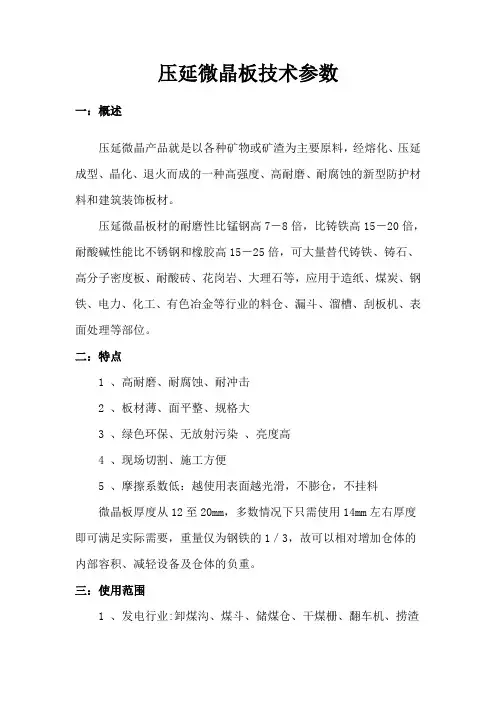
压延微晶板技术参数
一:概述
压延微晶产品就是以各种矿物或矿渣为主要原料,经熔化、压延成型、晶化、退火而成的一种高强度、高耐磨、耐腐蚀的新型防护材料和建筑装饰板材。
压延微晶板材的耐磨性比锰钢高7-8倍,比铸铁高15-20倍,耐酸碱性能比不锈钢和橡胶高15-25倍,可大量替代铸铁、铸石、高分子密度板、耐酸砖、花岗岩、大理石等,应用于造纸、煤炭、钢铁、电力、化工、有色冶金等行业的料仓、漏斗、溜槽、刮板机、表面处理等部位。
二:特点
1 、高耐磨、耐腐蚀、耐冲击
2 、板材薄、面平整、规格大
3 、绿色环保、无放射污染、亮度高
4 、现场切割、施工方便
5 、摩擦系数低:越使用表面越光滑,不膨仓,不挂料
微晶板厚度从12至20mm,多数情况下只需使用14mm左右厚度即可满足实际需要,重量仅为钢铁的1/3,故可以相对增加仓体的内部容积、减轻设备及仓体的负重。
三:使用范围
1 、发电行业:卸煤沟、煤斗、储煤仓、干煤栅、翻车机、捞渣
机、水处理等。
2 、化工行业:防腐蚀地面、泵基础等。
3 、煤炭行业:矸石仓、介质桶、刮板机、斗提机、溜槽、筛下漏斗等内的耐磨衬板。
4 、钢铁行业:高炉混料仓、烧结料仓、给料机、制球机等。
四:技术参数
压延微晶板检测标准
参照标准:JC514.1-93
压延微晶板的部分物理性能。
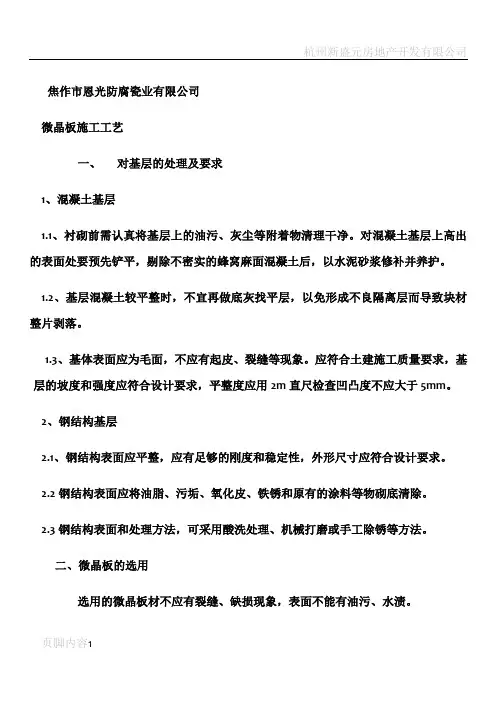
焦作市恩光防腐瓷业有限公司微晶板施工工艺一、对基层的处理及要求1、混凝土基层1.1、衬砌前需认真将基层上的油污、灰尘等附着物清理干净。
对混凝土基层上高出的表面处要预先铲平,剔除不密实的蜂窝麻面混凝土后,以水泥砂浆修补并养护。
1.2、基层混凝土较平整时,不宜再做底灰找平层,以免形成不良隔离层而导致块材整片剥落。
1.3、基体表面应为毛面,不应有起皮、裂缝等现象。
应符合土建施工质量要求,基层的坡度和强度应符合设计要求,平整度应用2m直尺检查凹凸度不应大于5mm。
2、钢结构基层2.1、钢结构表面应平整,应有足够的刚度和稳定性,外形尺寸应符合设计要求。
2.2钢结构表面应将油脂、污垢、氧化皮、铁锈和原有的涂料等物砌底清除。
2.3钢结构表面和处理方法,可采用酸洗处理、机械打磨或手工除锈等方法。
二、微晶板的选用选用的微晶板材不应有裂缝、缺损现象,表面不能有油污、水渍。
三、粘贴材料1、硅质胶泥1.1、硅质胶泥施工的环境温度宜为5-30℃,相对湿度不宜大于80%。
当施工环境低于5℃时,应采取加热保温措施。
1.2、在施工完毕后应进行保养,可采用酸洗发,分2次进行养护。
1.3、在施工及保养期间,严禁与水蒸气接触。
2、环氧树脂胶泥:2.1、环氧树脂胶泥是以合成树脂,耐腐蚀粉料,固化剂,促进剂等按一定的比例配制而成的一类防腐蚀泥状粉料。
2.2、环氧胶泥的物理力学性能:密度 1.82-2.0 g/cm压缩强度90-130 MPa拉伸强度15-18 MPa收缩率0.2%黏接强度 1.9-3.9 Mpa3、呋喃胶泥:密度 2.0 g/cm抗压强度70 MPa黏接强度 1.5-2.5 Mpa收缩率 1.5%四、衬砌微晶板1、微晶板的施工,可采用错缝挤浆法和干砌法进行施工。
2、施工应砌平整,相邻衬板间不应有迎着物料运动方向的凸台。
3、当衬砌设备转角边缘处板材尺寸不够时,应按实际尺寸现场加工板材。
4、应在微晶板的施工面上打灰,中间应略高,不应再板面四周进行打灰。

微晶玻璃生产工艺设计微晶玻璃是一种具有特殊纹理和光泽的新型玻璃材料,广泛用于建筑装饰、家具制作和艺术品等领域。
设计微晶玻璃生产工艺,需要考虑原料选择、熔制工艺、成型工艺和表面处理等方面。
首先,原料选择是设计微晶玻璃生产工艺的重要一环。
微晶玻璃的主要成分是氧化硅和氧化铝。
其中,氧化硅起到增加玻璃硬度、透明度和特殊纹理的作用,氧化铝则有助于提高玻璃的强度和耐热性。
根据产品要求,可以选择不同比例的氧化硅和氧化铝进行配料。
其次,熔制工艺是微晶玻璃生产的关键一环。
常用的熔制工艺包括电阻炉熔制、电弧炉熔制和燃气炉熔制等。
电阻炉熔制适用于小批量的生产,电弧炉熔制适用于大批量的生产,燃气炉熔制则适用于中小型企业。
在熔制过程中,需要控制好熔化温度、保持一定的搅拌强度,以确保均匀熔化和杂质的去除。
然后,成型工艺是微晶玻璃成品的关键环节。
常用的成型工艺包括压延和铸造。
压延工艺适用于生产平面微晶玻璃板材,需要在熔融玻璃表面施加压力,然后通过定型工具将玻璃板材压延成所需的厚度和尺寸。
铸造工艺适用于生产特殊形状的微晶玻璃制品,通过在特定模具中倒入熔融玻璃,并经过冷却定型来得到成品。
最后,表面处理是微晶玻璃制品的重要一环。
常用的表面处理工艺包括抛光、磨砂和喷砂等。
抛光工艺可以使微晶玻璃表面变得光滑亮丽;磨砂工艺可以使微晶玻璃表面变得均匀细腻;喷砂工艺则可以产生丰富的纹理效果。
根据产品需要,可以选择不同的表面处理工艺,以满足客户的要求。
综上所述,设计微晶玻璃生产工艺需要考虑原料选择、熔制工艺、成型工艺和表面处理等方面。
通过合理的工艺设计和优质的原材料,可以生产出质量优良、纹理独特的微晶玻璃制品。
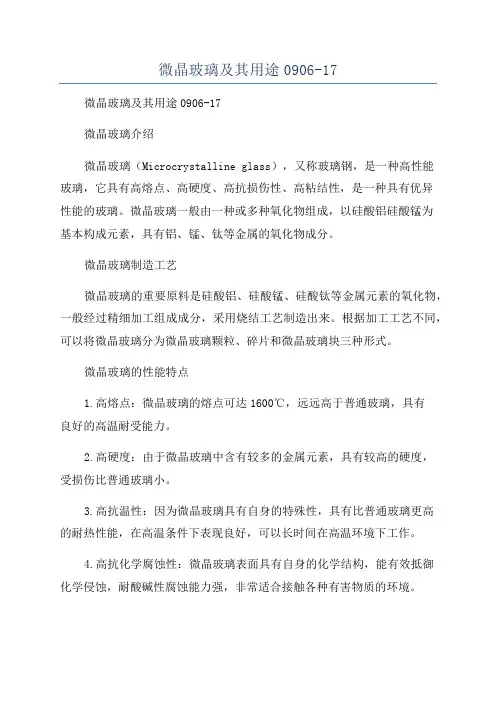
微晶玻璃及其用途0906-17
微晶玻璃及其用途0906-17
微晶玻璃介绍
微晶玻璃(Microcrystalline glass),又称玻璃钢,是一种高性能
玻璃,它具有高熔点、高硬度、高抗损伤性、高粘结性,是一种具有优异
性能的玻璃。
微晶玻璃一般由一种或多种氧化物组成,以硅酸铝硅酸锰为
基本构成元素,具有铝、锰、钛等金属的氧化物成分。
微晶玻璃制造工艺
微晶玻璃的重要原料是硅酸铝、硅酸锰、硅酸钛等金属元素的氧化物,一般经过精细加工组成成分,采用烧结工艺制造出来。
根据加工工艺不同,可以将微晶玻璃分为微晶玻璃颗粒、碎片和微晶玻璃块三种形式。
微晶玻璃的性能特点
1.高熔点:微晶玻璃的熔点可达1600℃,远远高于普通玻璃,具有
良好的高温耐受能力。
2.高硬度:由于微晶玻璃中含有较多的金属元素,具有较高的硬度,
受损伤比普通玻璃小。
3.高抗温性:因为微晶玻璃具有自身的特殊性,具有比普通玻璃更高
的耐热性能,在高温条件下表现良好,可以长时间在高温环境下工作。
4.高抗化学腐蚀性:微晶玻璃表面具有自身的化学结构,能有效抵御
化学侵蚀,耐酸碱性腐蚀能力强,非常适合接触各种有害物质的环境。

Product descriptionProduct Name: Black Transparent Electromagnetic Oven panelGuangdong Kedi Glass-ceramic Industrial Co., Ltd.1 Scope of ApplicationThis manual applies to black transparent glass ceramics panel.2 Reference StandardGuangdong Province Industry Standard, Q/PKT 02-2007Broad Black Transparent Glass-ceramic Plate.3 MaterialBlack transparent glass ceramics are used to meet the special requirements of electromagnetic ovenStandard features which are to be described respectively, fit the RoHS rules.3.1 Characteristics of glass ceramics3.1.1 Maximum Service Temperature:The original color of the plate will change at the temperature of 780 ℃.3.1.2 Temperature of Thermal Shock780 ℃ (thermal shock resistance test: after heating the electric furnace and keeping the temperature at 780℃, place the plate in it for 30 minutes, the characteristics of the plate keeps stable when it is immediately thrown into the water).4 Specifications4.1 The size and shape of the electromagnetic stove panel are subject to the requirement diagram.4.2 Dimensions and test method of the product are measured in accordance with the design and the Vernier caliper.4.3 The amount of deformation is within 1.0mm (in the process of testing, the product should be placed on the horizontal platform, and measured by a plug gauge coordinated a standard ruler. Only ruler is allowed to be place on the plate.)4.4 The allowance error of thickness is within ±0.5mm.4.5 The allowance error of the straight edge is within ±0.5mm. The arc edge is smooth, without broken and flanging edge.4.6 The R angle of product is within ±0.3mm. The perpendicularity and parallelism is presented in Figure 1.a or a’ should be within 1mm:b or b’ should be within 1mm:Edge c should be alongside with the right angle.Figure 15 The Specification of Shape5.1 Panel: bright and uniform color without apparent sand inclusion, scratch, blot or edge broken.5.2 Screen-printing: the pattern and color are in accordance with the design for the customer.6 Physical and Chemical PropertiesThe reference of physical and chemical properties is in the following table:Index of Physical and Chemical Properties6.1 Thermal Properties6.1.1 Heat ResistanceIn non-screen printing condition, no deformation after 100h in the environment of 500℃.6.1.2 Thermal Shock ResistanceHeated for 30min in the temperature of 760℃, no deformation after immersion in water of 20℃.6.1.3 Thermal DeformationThe thermal expansion coefficient of the plate material is -1.5~+5×10-7/℃at the range of 30℃~700℃. Testing reference: GB/T16920-1997. The heating rate is 5℃/min in the medium of air oxygen. Testing equipment: NETZSCHDLL-402C.6.2 Mechanical Properties6.2.1 Moh’s StrengthThe Moh’s str ength is 6.5, under the execution of term 6.5.4 in JC/T.6.2.2 Shock StrengthTesting is executed by the following mechanical strength test. The appearance of the plate remains the same after the testing.Products (test sample) is placed in accordance with that in Figure 2. Three continuous hits was exerted on the center point of test sample by a 525g solid steel ball of 50mm in diameter.Figure 26.3 Chemical Properties6.3.1 Acid ResistanceUnder non-screen printing condition, the corrosion rate of glass-ceramic plate is under 0.25mg/cm2 after 24h immersion in 5% hydrochloric acid solution at 90℃.6.3.2 Alkali ResistanceUnder non-screen printing condition, the corrosion rate of glass-ceramic plate is under 0.3mg/cm2 after 24h immersion in 5% sodium carbonate solution at 90℃.7 Screen-printing Property7.1 Temperature Property of Screen-printingAfter thermal shock test, stripping test was executed on the screen-printed part on the surface. Tapes were pull out from the surface at an angle of 45°,no appearance spalling happens.The adhesive force of the tape should be above 2.94N/10mm.7.2 Durability of the Screen-printingUnder normal serviceable condition, no discoloration or spallinghappens. The limit temperature of the normal serviceable condition is 560℃. Scratching the panel surface with metal, glass etc. is forbidden. Remaining food residues is forbidden.7.3 The Abrasion Resistance of Screen-printingAbrasion test is implemented as the following. No scratch or change in gloss happens.Testing method:7.4 Alkali Resistance of Screening-printingCoating the surface with strong base solvent and cover with plastic wrap at 70℃after 5h, the color remains the same, and nothing abnormal, such as printing deformation happens.8 Testing MethodsFor dimension deviation, and appearance quality, random sampling of semi-products is used. For finished products, full check is applied.9 Logo and Packaging9.1 A control number is printed on the bottom of each product. The external packing of the product should be marked with factory name, address, registered trademarks, and weight.9.2 The corrugated case is used as the external and external packing, with the external packing sealed with tape and inner packing sealed with heat-resistance tape. Between the product pear wool paper is padded, avoiding any contact between products.10 Transportation and Storage10.1 In the process of transportation, vibration should be avoided. Awns should be used to avoid exposing the products to the sun and rain. Great care should be taken during loading and unloading.10.2 The product should be stored in the warehouse with fine air circulation and without corrosive gases, and the platform of storage should be 30cm above the ground. Normally the height of stock pile should be limited to 3 layers.。
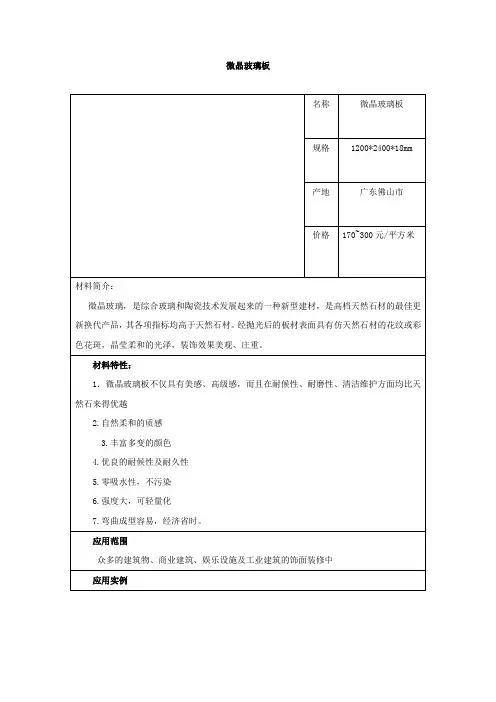

Product descriptionProduct Name: Black Transparent Electromagnetic Oven panelGuangdong Kedi Glass-ceramic Industrial Co., Ltd.1 Scope of ApplicationThis manual applies to black transparent glass ceramics panel.2 Reference StandardGuangdong Province Industry Standard, Q/PKT 02-2007Broad Black Transparent Glass-ceramic Plate.3 MaterialBlack transparent glass ceramics are used to meet the special requirements of electromagnetic ovenStandard features which are to be described respectively, fit the RoHS rules.3.1 Characteristics of glass ceramics3.1.1 Maximum Service Temperature:The original color of the plate will change at the temperature of 780 ℃.3.1.2 Temperature of Thermal Shock780 ℃ (thermal shock resistance test: after heating the electric furnace and keeping the temperature at 780℃, place the plate in it for 30 minutes, the characteristics of the plate keeps stable when it is immediately thrown into the water).4 Specifications4.1 The size and shape of the electromagnetic stove panel are subject to the requirement diagram.4.2 Dimensions and test method of the product are measured in accordance with the design and the Vernier caliper.4.3 The amount of deformation is within 1.0mm (in the process of testing, the product should be placed on the horizontal platform, and measured by a plug gauge coordinated a standard ruler. Only ruler is allowed to be place on the plate.)4.4 The allowance error of thickness is within ±0.5mm.4.5 The allowance error of the straight edge is within ±0.5mm. The arc edge is smooth, without broken and flanging edge.4.6 The R angle of product is within ±0.3mm. The perpendicularity and parallelism is presented in Figure 1.a or a’ should be within 1mm:b or b’ should be within 1mm:Edge c should be alongside with the right angle.Figure 15 The Specification of Shape5.1 Panel: bright and uniform color without apparent sand inclusion, scratch, blot or edge broken.5.2 Screen-printing: the pattern and color are in accordance with the design for the customer.6 Physical and Chemical PropertiesThe reference of physical and chemical properties is in the following table:Index of Physical and Chemical Properties6.1 Thermal Properties6.1.1 Heat ResistanceIn non-screen printing condition, no deformation after 100h in the environment of 500℃.6.1.2 Thermal Shock ResistanceHeated for 30min in the temperature of 760℃, no deformation after immersion in water of 20℃.6.1.3 Thermal DeformationThe thermal expansion coefficient of the plate material is -1.5~+5×10-7/℃at the range of 30℃~700℃. Testing reference: GB/T16920-1997. The heating rate is 5℃/min in the medium of air oxygen. Testing equipment: NETZSCHDLL-402C.6.2 Mechanical Properties6.2.1 Moh’s StrengthThe Moh’s str ength is 6.5, under the execution of term 6.5.4 in JC/T.6.2.2 Shock StrengthTesting is executed by the following mechanical strength test. The appearance of the plate remains the same after the testing.Products (test sample) is placed in accordance with that in Figure 2. Three continuous hits was exerted on the center point of test sample by a 525g solid steel ball of 50mm in diameter.Figure 26.3 Chemical Properties6.3.1 Acid ResistanceUnder non-screen printing condition, the corrosion rate of glass-ceramic plate is under 0.25mg/cm2 after 24h immersion in 5% hydrochloric acid solution at 90℃.6.3.2 Alkali ResistanceUnder non-screen printing condition, the corrosion rate of glass-ceramic plate is under 0.3mg/cm2 after 24h immersion in 5% sodium carbonate solution at 90℃.7 Screen-printing Property7.1 Temperature Property of Screen-printingAfter thermal shock test, stripping test was executed on the screen-printed part on the surface. Tapes were pull out from the surface at an angle of 45°,no appearance spalling happens.The adhesive force of the tape should be above 2.94N/10mm.7.2 Durability of the Screen-printingUnder normal serviceable condition, no discoloration or spallinghappens. The limit temperature of the normal serviceable condition is 560℃. Scratching the panel surface with metal, glass etc. is forbidden. Remaining food residues is forbidden.7.3 The Abrasion Resistance of Screen-printingAbrasion test is implemented as the following. No scratch or change in gloss happens.Testing method:7.4 Alkali Resistance of Screening-printingCoating the surface with strong base solvent and cover with plastic wrap at 70℃after 5h, the color remains the same, and nothing abnormal, such as printing deformation happens.8 Testing MethodsFor dimension deviation, and appearance quality, random sampling of semi-products is used. For finished products, full check is applied.9 Logo and Packaging9.1 A control number is printed on the bottom of each product. The external packing of the product should be marked with factory name, address, registered trademarks, and weight.9.2 The corrugated case is used as the external and external packing, with the external packing sealed with tape and inner packing sealed with heat-resistance tape. Between the product pear wool paper is padded, avoiding any contact between products.10 Transportation and Storage10.1 In the process of transportation, vibration should be avoided. Awns should be used to avoid exposing the products to the sun and rain. Great care should be taken during loading and unloading.10.2 The product should be stored in the warehouse with fine air circulation and without corrosive gases, and the platform of storage should be 30cm above the ground. Normally the height of stock pile should be limited to 3 layers.。

人造板材幕墙工程技术规范JGJ 336-2016本规范主要技术内容是:1 总则;2 术语和符号;3 材料;4 建筑设计;5 结构设计;6 面板及其连接设计;7 支承结构设计;8 加工制作;9 安装施工;10 工程验收;11 保养和维修。
1 总则1.0.1 为贯彻执行国家的技术经济政策,使人造板材幕墙工程做到技术先进、安全可靠、美观适用、节能环保,制定本规范。
1.0.2 本规范适用于地震区和抗震设防烈度不大于8度地震区的民用建筑用瓷板、陶板、微晶玻璃板、石材蜂窝复合板、高压热固化木纤维板和纤维水泥板等外墙用人造板材幕墙工程。
人造板材幕墙的应用高度不宜大于100m。
1.0.3 在正常使用状态下,人造板材幕墙应具有良好的工作性能。
抗震设计的人造板材幕墙,在遭受多遇地震影响时,一般不需修理即可继续使用;在遭受设防烈度地震影响时,有轻微破坏,经一般修理后可继续使用;在遭受预估的罕遇地震影响时,幕墙面板支承构件不得脱落。
1.0.4 人造板材幕墙工程除应符合本规范外,尚应符合国家现行有关标准的规定。
2 术语和符号2.1 术语2.1.1 人造板材幕墙 artificial panel curtain wall面板材料为人造外墙板的建筑幕墙,包括瓷板幕墙、陶板幕墙、微晶玻璃板幕墙、石材蜂窝板幕墙、木纤维板幕墙和纤维水泥板幕墙。
2.1.2 人造外墙板 artificial panel for exterior application 采用人造材料或天然材料与人造材料复合制成的、适用于建筑幕墙使用的板材。
2.1.3 瓷板幕墙 porcelain plate curtain wall以建筑幕墙用瓷板为面板的人造板材幕墙。
2.1.4 陶板幕墙 terracotta panel curtain wall以建筑幕墙用陶板为面板的人造板材幕墙。
2.1.5 微晶玻璃幕墙 glass-ceramics curtain wall以建筑装饰用微晶玻璃板为面板的人造板材幕墙。

JC/T 872《建筑装饰用微晶玻璃》修订编制说明《建筑装饰用微晶玻璃》起草组二零一八年五月《建筑装饰用微晶玻璃》建材行业标准编制说明一、工作简况(一)任务来源根据“工业和信息化部项目编号:2016-0470T-JC”下达的的要求,由建筑材料工业技术监督研究中心牵头负责“JC/T872建筑装饰用微晶玻璃”建材行业标准的编制工作。
本标准由中国建筑材料联合会提出并归口(二)起草单位和工作组成员及所做的工作本标准的起草单位为建筑材料工业技术监研究中心、中国建筑材料科学研究总院。
主要起草人有后补:(三)主要工作过程1.成立工作组建筑材料工业技术监督研究中心接到任务后,首先着手对标准的国内外情况进行调研,征集参加标准制定的企业单位,提出了标准修订工作计划。
2016年9月,在江西宜丰召开首次工作会议,对标准的初稿和主要内容进行讨论,成立了标准工作组。
2.样品征集和验证试验首次工作会后,工作小组立即着手进行样品的征集工作,下发样品征集通知,广泛收集国内建筑装饰用微晶玻璃样品,共收到4家单位的48个样品进行试验验证。
与此同时,工作组起草了试验方案,广泛征求各成员及专家意见,确定了验证试验的试验项目和方法,由标准起草组组织相关专业人员依照确定的试验项目和方法进行试验验证工作。
2017年1月工作组召开了第二次工作会议(微信网络会议),对标准讨论稿进行研讨。
根据会议讨论情况,工作组面向建筑装饰用微晶玻璃生产企业再次征集样品,进行了补充试验验证,同时对部分样品进行重复性试验验证。
2017年5月在认真听取各方意见和综合研究实验验证结果的情况下,标准起草组对标准文稿进行了仔细修改,形成了征求意见稿。
二、标准制定原则和主要内容的依据说明(一)标准制定原则《建筑装饰用微晶玻璃》建材行业标准的修订,规范建筑装饰用微晶玻璃的概念、性能指标为目的,为建筑装饰用微晶玻璃市场的发展提供统一的评判依据及标准。
标准的编制过程中,遵从积极采用国内外先进标准原则、技术创新原则、与其他标准协调性原则、标准文本规范性适用性原则。
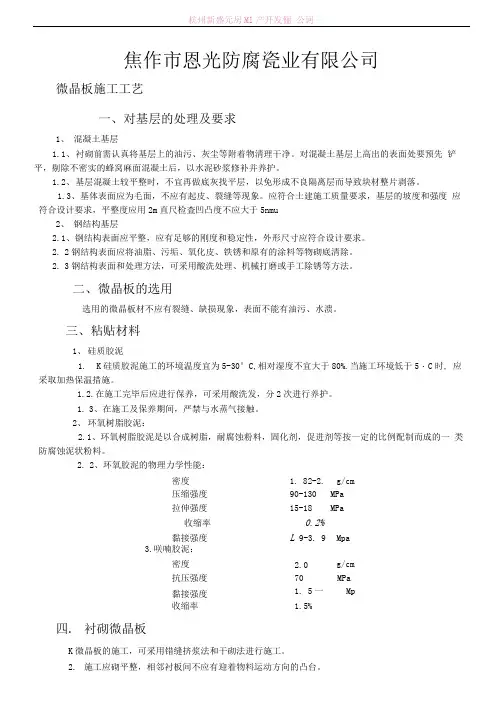
杭州新盛元房Ml产开发俪公诃焦作市恩光防腐瓷业有限公司微晶板施工工艺一、对基层的处理及要求1、混凝土基层1.1、衬砌前需认真将基层上的油污、灰尘等附着物清理干净。
对混凝土基层上高出的表面处要预先铲平,剔除不密实的蜂窝麻面混凝土后,以水泥砂浆修补并养护。
1.2、基层混凝土较平整时,不宜再做底灰找平层,以免形成不良隔离层而导致块材整片剥落。
1.3、基体表面应为毛面,不应有起皮、裂缝等现象。
应符合土建施工质量要求,基层的坡度和强度应符合设计要求,平整度应用2m直尺检査凹凸度不应大于5nmu2、钢结构基层2.1、钢结构表面应平整,应有足够的刚度和稳定性,外形尺寸应符合设计要求。
2.2钢结构表面应将油脂、污垢、氧化皮、铁锈和原有的涂料等物砌底清除。
2.3钢结构表面和处理方法,可采用酸洗处理、机械打磨或手工除锈等方法。
二、微晶板的选用选用的微晶板材不应有裂缝、缺损现象,表面不能有油污、水溃。
三、粘贴材料1、硅质胶泥1.K硅质胶泥施工的环境温度宜为5-30°C,相对湿度不宜大于80%.当施工环境低于5・C时, 应采取加热保温措施。
1.2.在施工完毕后应进行保养,可采用酸洗发,分2次进行养护。
1.3、在施工及保养期间,严禁与水蒸气接触。
2、环氧树脂胶泥:2.1、环氧树脂胶泥是以合成树脂,耐腐蚀粉料,固化剂,促进剂等按一定的比例配制而成的一类防腐蚀泥状粉料。
2.2、环氧胶泥的物理力学性能:密度 1. 82-2.0 g/cm压缩强度90-130 MPa拉伸强度15-18 MPa 收缩率0.2%黏接强度L 9-3. 9 Mpa 3.咲喃胶泥:密度 2.0 g/cm抗压强度70 MPa黏接强度 1. 5一2・ 5Mp j收缩率 1.5% 四. 衬砌微晶板K微晶板的施工,可采用错缝挤浆法和干砌法进行施工。
2.施工应砌平整,相邻衬板间不应有迎着物料运动方向的凸台。
3、当衬砌设备转角边缘处板材尺寸不够时,应按实际尺寸现场加工板材。
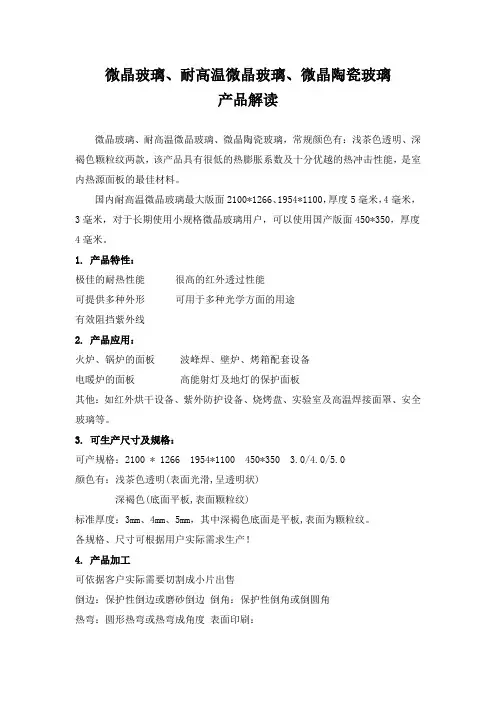
微晶玻璃、耐高温微晶玻璃、微晶陶瓷玻璃产品解读微晶玻璃、耐高温微晶玻璃、微晶陶瓷玻璃,常规颜色有:浅茶色透明、深褐色颗粒纹两款,该产品具有很低的热膨胀系数及十分优越的热冲击性能,是室内热源面板的最佳材料。
国内耐高温微晶玻璃最大版面2100*1266、1954*1100,厚度5毫米,4毫米,3毫米,对于长期使用小规格微晶玻璃用户,可以使用国产版面450*350,厚度4毫米。
1. 产品特性:极佳的耐热性能很高的红外透过性能可提供多种外形可用于多种光学方面的用途有效阻挡紫外线2. 产品应用:火炉、锅炉的面板波峰焊、壁炉、烤箱配套设备电暖炉的面板高能射灯及地灯的保护面板其他:如红外烘干设备、紫外防护设备、烧烤盘、实验室及高温焊接面罩、安全玻璃等。
3. 可生产尺寸及规格:可产规格:2100 * 1266 1954*1100 450*350 3.0/4.0/5.0颜色有:浅茶色透明(表面光滑,呈透明状)深褐色(底面平板,表面颗粒纹)标准厚度:3mm、4mm、5mm,其中深褐色底面是平板,表面为颗粒纹。
各规格、尺寸可根据用户实际需求生产!4. 产品加工可依据客户实际需要切割成小片出售倒边:保护性倒边或磨砂倒边倒角:保护性倒角或倒圆角热弯:圆形热弯或热弯成角度表面印刷:5.机械性能: Density at 25℃的密度ρ 2.6g/cm36. 热学性能:热线性膨胀系数а(20-700℃)(0±0.5)*10-6K-1热容: cp(20-100℃)0.8K」*(KQ*K)-1导热系数: A(90℃)1.6W*(m*k)-17. 耐温性能:耐高温微晶玻璃具有十分强势的耐温性能。
热稳定性(冷热冲击): △T 700℃;安全耐温: ≤800℃;最大耐温:≤1000℃8. 同片温差性能同片温差性能值是玻璃片中心与边沿可承受的最大温度差异即在δma x ≦700℃不会因为热应力问题而破裂!耐热冲击性能值是指玻璃片可承受最大温度变化即在δma x ≦700℃不会因为热应力问题而破裂9. 化学性能:耐水性 ISO719/DIN12111 HGB1耐酸性 ISO1776/DIN12116 3耐碱性 ISO695/DIN52322 A210、产品研发耐高温微晶玻璃,价格低廉,规格版面大,耐热温度高,目前正逐渐成为耐热高温玻璃市场的主流使用产品。
QMCR 燃气具公司企业标准
QMCR- -2009 微晶玻璃面板技术要求
2009-01-20发布 2009-01-20实施美的厨卫事业部燃气具公司发布
微晶玻璃面板技术要求
1 范围
本标准规范了微晶玻璃面板的技术要求、试验方法、质量评定程序、标志、包装、运输和贮存。
本标准适用于专用于电热式灶具的微晶玻璃面板。
本标准适用于广东美的厨卫电器制造有限公司生产的气电灶。
2 规范性引用文件
下列文件中的条款通过本规范的引用而成为本规范的条款。
GB 4706.22 家用和类似用途电器的安全驻立式电灶、灶台、烤炉及类似用途器具的特殊要求DIN 12116 测试玻璃耐沸水溶解盐酸冲击性的试验和分类方法
ISO 695 玻璃抗沸腾碱溶液腐蚀性.试验和分类方法
DIN ISO 719 玻璃.98℃时玻璃晶粒的耐水解性.试验方法和分类
3 要求
3.1外观质量
3.1.1 气泡
普通光照条件下,距离0.8米处观测,不应看到明显凸起,以及无凸起的、被埋藏的气泡。
3.1.2 碎喳
在边缘及孔周边,普通光照条件下,距离0.8米处观测,不应看到有明显的碎喳。
3.1.3 划痕
指甲轻微划过,无阻碍感。
普通光照条件下,距离0.8米出观测,不应看到有明显的划痕。
3.1.4 底部结构
底部强度颗粒,完整,均匀分布。
3.1.5 表面彩釉
3.1.5.1 热稳定性
在580°C时,将微晶板间断加热30分钟,冷却30分钟,如此反复,4000小时印刷彩釉的外观无明显改变。
3.1.5.2 附着性能要求
用12X60mm的胶带粘贴于印刷彩釉上,在65°C环境中强化粘力,冷却后迅速扯下胶带,不应有任何超过0.5mm的印刷彩釉脱落。
3.2 结构尺寸
3.2.1 外形尺寸
3.2.2 孔尺寸公差
3.2.3 平面度公差
3.3.1 耐酸性
经过1mol/L浓度的HCL试验后,玻璃表面不受损,彩釉不掉色,不变色。
3.3.2 耐碱性
经过1mol/L浓度的NaOH试验后,玻璃表面不受损,彩釉不掉色,不变色。
3.3.3 耐水解性
经过煮水或者煮油试验,玻璃无损伤。
3.4 强度要求
经冲击锤试验及平底铝锅冲击试验不应出现裂纹和破损。
3.5 抗热冲击性
在温度700°C时不允许出现破裂,文字、图案不出现变形、变色等异常。
3.6 抗温度梯度
在温度梯度ΔT=700°C时,不应出现文字、图案变形、变色等异常,不应出现裂纹、破损请异常。
3.7 耐用性
微晶玻璃板在580°C温度下停留5000小时,性能不允许改变。
3.8 硬度要求:
能经受6H的铅笔硬度计磨檫表面印刷彩釉无掉色、刮伤等异常。
4 检验方法
4.1 外观质量:
气泡、碎喳、划痕及底部结构在普通光照条件下,在距离0.8处目测。
表面彩釉热稳定性测试方法:将微晶玻璃置于恒温箱中,保持恒温箱内的温度为580°C,加热微晶玻璃板30分钟后冷却30分钟,如此反复4000小时后,印刷彩釉的外观无明显改变。
表面彩釉附着性能测试方法:在常温下先将一段12X60mm的3M胶带粘贴在微晶玻璃的印刷彩釉上,再将此粘有胶带的微晶玻璃板放入65°C的恒温箱内,等待15分钟,以加强粘贴力。
取出室温冷却后,迅速扯下胶带。
印刷彩釉脱落情况符合3.1.5.2的要求。
4.2 结构尺寸检验:
用游标卡尺按图纸测量,公差满足3.2各项要求。
4.3 化学性能试验
4.3.1 耐酸性试验:将玻璃面板的彩釉面向上,用橡皮泥圈成一个50mm×50mm高5mm的池,用1mol/L 浓度的HCl溶液放入池内,酸液加至深3mm,浸泡1h,然后清洁干净,玻璃表面不受损,彩釉不掉皮、不变色。
4.3.2 耐碱性试验:将玻璃面板的面向上,用橡皮泥圈成一个50mm×50mm高5mm的池,用1mol/L 浓度的NaOH溶液放入池内,碱液加至深3mm,浸泡1h,然后清洁干净,玻璃表面不受损,彩釉不变色。
4.3.3 耐水解性试验:连续煮水360h或者连续煮油96h,或者干烧至保护20次,玻璃板不会有开裂或者破损现象。
4.4 强度试验:
用一个底部直径为120±10mm的平底铝制容器,内放置1.3 kg的沙装物,总质量1.80±0.01kg,从150mm 的高度跌落到烹饪区域10次。
4.5抗热冲击性试验:
将样件放入700°C恒温箱至热平衡后,取出冷却至室温。
4.6 抗温度梯度试验:
将样件放入700°C恒温箱中至热平衡后,取出,立刻投入到0°C的冰水混合物中。
4.7 耐用性试验:
将样件置于恒温箱中,使恒温箱的温度维持在580°C,加热5000小时,样件无色变,无开裂、破损等异常。
4.8 硬度试验:
室温下用6H的铅笔硬度计磨擦样件表面彩釉,15秒后停止。
5 检验规则
分来料检验和型式检验,抽样检验依据公司抽样方案。
5.1 来料检验
每批微晶玻璃面板须检验合格后,才可上线使用,接收及抽样方案依据公司相关方案执行。
5.2 型式试验
有下列情况之一时应进行型式试验
a)新产品设计定型和生产定型;
b)生产过程中如结构、材料、工艺有重大改变,可能影响产品质量时;
c)出厂检验结果与上次型式试验有较大差异时;
d)停厂一年后恢复生产时;
e)正常生产情况下,每半年一次;
f)国家质量监督机构提出进行型式试验要求时。
5.3 不合格项目分类见下表:
6 标志、包装、运输及贮存
6.1 标志
6.1.1产品包装上应有标志
标志内容包括有:
a)厂名与商标;b)产品型号或编号;c)生产日期;d)数量;e)重量;f)产品规格;g)执行标准;h)易碎物品,怕雨等符合GB191的规定
6.2 包装
6.2.1产品包装应按GB191的要求,有牢固的包装箱,应保证产品在一般的运输条件和保管条件下不被损坏。
6.2.2 包装箱内应有盖有制造厂质量检验部门印章的合格证。
6.3 运输
包装箱允许用任何方式进行运输,运输过程中应避免雨雪侵袭和机械损伤。
6.3贮存
产品应垂直贮存在干燥的室内,严禁与酸碱化学品一起贮存。
附加说明:
本标准由美的整体厨卫事业部燃气具公司提出并负责制订、解释、修改。
本标准为美的整体厨卫事业部燃气具公司内控标准,对客户特殊订购的产品应按合同书中具体要求执行。
本标准主要起草人:何就安、杨道平2008.1.18
本标准审核人:张云亮、徐关云、周海珍、张忠、周斌、罗顺波
本标准审批人:郑仪军。